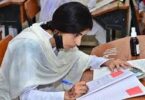FP. Report
PESHAWAR: Adequate resource provision is crucial to achieving the educational targets that include access, quality, transition, retention and environment. According to the available data 1.8 Million children, aged 5-17 are out of school in Khyber-Pakhtunkhwa. Of these, 64% are girls while 36% are boys and more children are adding into it every year, The Govt of Khyber Pakhtunkhwa can not find the solution without finding answers that are existing resources enough to meet the educational requirements in the province, What is the pattern of spending and allocation priorities in education sector &What are the key issues in funds’ utilization and budget-making process.
In Pakistan, the government expenditure (federal & provincial) on education is less than 3 per cent of GDP that puts Pakistan in the list of countries’ spending a lower portion of their GDP on education. It is the lowest even among South Asian and neighbouring countries. Bhutan, Afghanistan, Nepal, India and Iran are placed at higher positions by spending 5.9%, 4.8%, 4.7%, 3.8% and 2.93% of GDP on education respectively.
After the 18th Amendment, the education ministry devolved to provinces and now provincial governments are responsible for education-related matters. Provincial governments started allocating around 20% of their total budget for education. The federal government allocates only 2% of the total budget on education after devolving the ministry of education to provinces. It is time to manage more funds to meet the educational goals and targets. Throughout Pakistan, More funds are required to enrol 24 million out-of-school children (OOSC), aged 5-16 years, which constitute 47% of the total population of this age group according to the Pakistan Education Statistics.
Like other provinces,the major portion of education funds in Pakistan mostly goes to current expenditures out of which a significant amount goes to salaries while development schemes are less prioritized. A development budget provides for new infrastructure, new educational institutions to enrol Out School Children and capacity building exercises. The recurrent budget constitutes salaries of all the employees of the education ministry and related institutions, expenses on repairs and maintenance, and everyday operational expenses3. More than 80 per cent of the total budget is being spent on recurrent expenses.
While the low allocation of education funds is always highlighted as a problem, it is disappointing that often not all the allocated amount is spent or reaches the schools and every year there are lapses in education funds’ allocation and spending. While less clarity is available on the non-spending possible reasons behind the non-utilization of funds are complicated access to non-salary budget and unclear procedure of funds utilization. More issues are procurement issues, slow tendering due to red tape and lack of competent contractors therefore there is an increased need that Khyber Pakhtunkhwa Govt must pay special attention to the efficient utilization of funds by addressing all these and some more hidden issues that need to be explored.
According to Qamar Naseem an education right activist working for improved allocation to girls education and spending “ The lacunas in the public financing of education in Khyber Pakhtunkhwa require improvements to get maximum returns to public investment. Enhanced transparency and accountability of budget-making process and spending would help make allocations according to the needs of the public.






